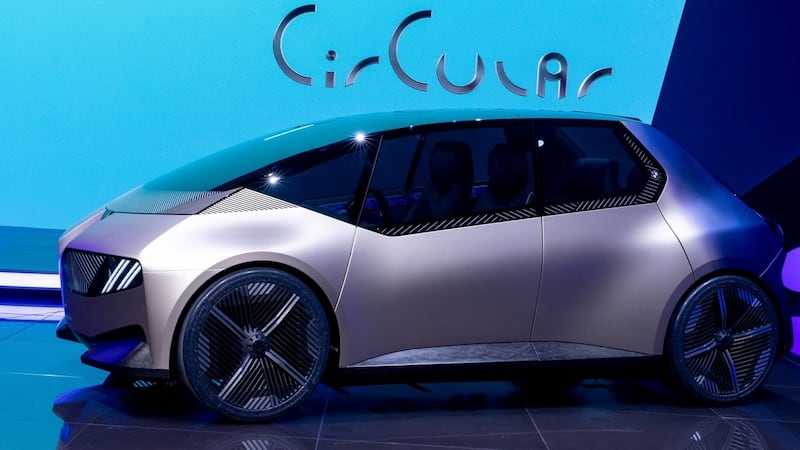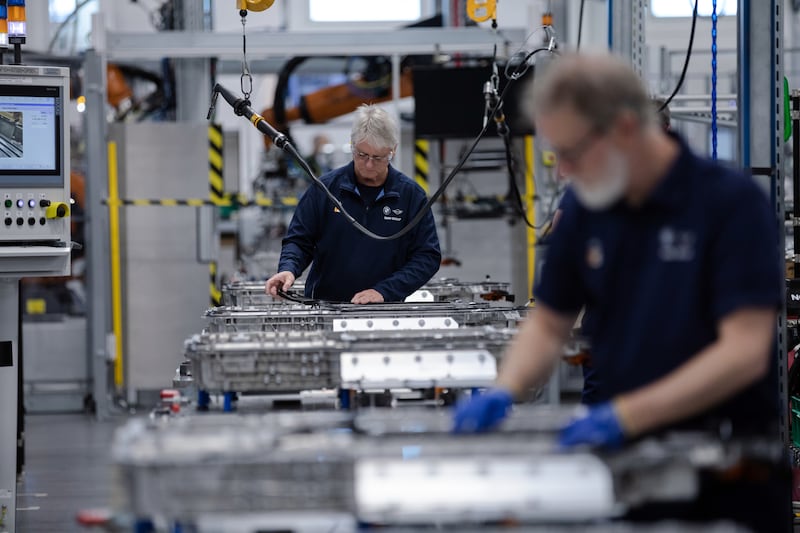“This is not just marketing spin, as I’m sure some people will accuse us of,” says Chris Brownridge from BMW as he opens proceedings. “This is existential for us. If we fail in this, we fail. It’s that simple.”
We are sat in a small lecture theatre within the Darwin Centre of the Natural History Museum in London. Unusually for a car-based event, there is not a single car visible. Instead there is a panel of people, each an expert in the sustainable economy, each one trying to find the key that unlocks fully circular manufacturing – that future where you recycle everything you make and make everything from recycling.
BMW has already touched on this future. Last year, the German car maker showed off the i Vision CirCular, a concept for a 2040 hatchback that’s made only of recycled materials, is designed from the get-go to be easy to disassemble and recover, and designed to be fully recyclable at the end of its life.
If tomorrow we wanted to build all of our cars out of recycled material, we simply wouldn’t be able to. There’s not enough material available
It’s a compelling idea, that making things and selling them can become fully environmentally-neutral and it’s a key pillar of BMW’s promise to become “100 per cent sustainable” in Brownridge’s words. “This is not just about electric” he says. “Last year, 40 per cent of the cars we sold had a plug. Electric doesn’t solve the problem, it simply moves the point of impact. We want to move to a position of having a total zero carbon footprint by 2050, and to have no environmental impact.”
READ MORE
It’s a tall order, but while you might expect a discussion such as this to be full of doom and gloom, it’s actually quite the opposite.
One of the speakers was Geoff Mulgan, a professor from University College London and a former adviser to Tony Blair’s government on the environmental economy. Aside from an expected broadside at the current UK government for a lack of eco-leadership in the past six years, his message was broadly hopeful.

“Look at the paper market in Europe,” says Mulgan. “The figure is that 74 per cent of all paper sold in Europe is now recycled, so that has been a major shift in little more than a generation, and it shows what can be done. In other areas it’s much less good – clothes for example. Only around 1 per cent of our clothing is recycled. I think the challenge to engineers is really interesting.
“If you look back at the 70s in Japan, the country says in the wake of the oil crisis in 1973 that the entire nation needed to dramatically cut its energy use. And in the space of five or six years, it did exactly that, and the process was led by the engineers working in Japanese companies who were leading the world at that time. They saw it as an empowering challenge, and succeeded in becoming much more energy self-sufficient.”
We need to bring back the idea that you repair things like cars, like washing machines, instead of junking them and replacing them
Empowerment is not a word one often associates with government rules handed down to individual companies, but it’s one that BMW says it’s embracing, actively looking for and asking for proper legislation on recycling and renewal in order to drive the innovation within the company.
“It’s something that this transformation really brings to us,” says Monika Dernai, BMW’s head of social sustainability. “It’s really interesting to watch how this goes through the company and how people come up with new ideas, ideas that maybe once would have been thought crazy. We have a type of man-made leather now that is made from pineapple, and another that’s made from bananas from food waste.”

Dernai admitted that having a fully-closed manufacturing loop is some way off, perhaps many decades away, telling The Irish Times that: “If tomorrow we wanted to build all of our cars out of recycled material, we simply wouldn’t be able to. There’s not enough material available.”
The problem is, specifically when talking about cars, that cars which are currently being scrapped are old enough that they weren’t built with total recyclability in mind. Simple things like shredding the steel body of a car with the copper wire of the wiring harness still in situ means that the steel can’t be used again, certainly not for safety-critical structures. Now, designers are incorporating simple but vital systems such as a handle built into the end of the wiring harness that allows it to be easily removed at scrapping time. Such things will take years to filter through the system, though.
It sounds revolutionary, but long ago there were electric vehicles driving around, delivering products to people’s door and taking away used items to be recycled and re-used. It was called a milk float
Another major issue is the traceability of components and indeed entire cars. “We have no control,” says Dernai. “The person we sell the car to initially is almost certainly not the person who will own the car at the end of its life. So we need to look both at ownership models – perhaps moving more and more towards leasing models – and the value of the car at the end of its life. Currently, when you scrap a car, it’s worth maybe £100 or €100 to you, so we need to incentivise the return and recycling of cars at the end of their lives.”
Dernai also says that we need to change the structure of ownership and even of the car market itself. The movement to a leasing-based, rather than sales-based, model opens up questions of how people who cannot afford a new car buy cars in the second-hand market. “I think in terms of people being able to afford new cars, I think we really need to also think about prolonging the life of cars, not having a used car market where you sell one car after each other, but maybe take a car and extend its lifespan,” says Dernai.
“So the idea could be that you freshen up the interior, and that you need and develop new skill sets in the aftermarket. You design your car so that for instance the seat can be easily removed and a new front seat can be moved in, and then it’s a used car that looks like a new car. It can have the same owner who then doesn’t buy a new car, but we still have a business model as BMW and the whole society.”
There’s a lot of talk about where we want to go, but not a lot of detail on how we get from here to there
That development of new skills, or more accurately the return of old skills, is increasingly seen as key to the circular economy, and in particular to creating sustainable employment. After all, if companies such as BMW are going to make fewer things that last longer, what happens to all those high-paying jobs in the car industry?
“We need to reinvigorate and re-dignify the idea of work, of manual work,” says Geoff Mulgan. “We need to bring back the idea that you repair things like cars, like washing machines, instead of junking them and replacing them.” There is, apparently, a $4.5-trillion potential bound up in the idea of a circular economy and shifting people to jobs that repair and extend the life cycle of bought items is a key component of that. It’s also a key message to consumers and citizens currently worrying more about the basic cost of living than they are about ensuring that the food they’re buying is appropriately packaged, or that their washing machine can be repaired instead of replaced.”
It’s also about simple ideas. As Mulgan puts it: “It sounds revolutionary, but long ago there were electric vehicles driving around, delivering products to people’s door and taking away used items to be recycled and reused. It was called a milk float.”
[ BMW’s battery revolution promises lower-cost electric vehicles with better rangeOpens in new window ]
That incentivisation to recycle can only come, says Mulgan, from proper, precise roadmaps to the future, laid out by governments and legislators. “That’s what we need now,” he says. “There’s a lot of talk about where we want to go, but not a lot of detail on how we get from here to there.”
A firm collaboration between legislators and even competing companies is what’s needed, says BMW’s Dernai, even if that triggers the antennae of those who worry about antitrust issues.
“I think that’s one of the issues that circular economy has, that you need so many people working together, that also you need to be working with competitors, which is frowned upon, you need to set standards, which is difficult. So but I think it needs to be a joint approach, otherwise it won’t work,” Dernai says.
“I think this is a new approach that we have where industry and regulators sort of battle each other and work together to shape the regulation to fit the industry and to also fit the global requirements.”





















